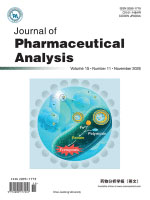2025, 15(7): 101203.
doi: 10.1016/j.jpha.2025.101203
Abstract:
Suboptimal treatment of laryngeal squamous cell carcinoma (LSCC) provides poor survival rate. The poor bioavailability, resistance to cetuximab (Cet), and the instability of small interfering RNA (siRNA) limit their efficacy in LSCC therapy. The present study has been aimed to develop a Cet and focal adhesion kinase (FAK) siRNA (siFAK) co-delivery nanosystem. Zeolitic imidazolate framework-8 (ZIF-8), with its large specific surface area and pH-responsive properties, is an ideal delivery carrier allowing controlled drug release in the acidic tumor microenvironment. Therefore, Cet was loaded onto ZIF-8 and encapsulated in a TU177 cell membrane (TCM) after the electrostatic adsorption of siFAK. Fourier transform infrared (FTIR) spectroscopy, transmission electron microscopy (TEM), scanning electron microscopy (SEM), zeta potential, X-ray diffraction, and particle size analyses were deployed to characterize Cet/siFAK@ZIF-8@TCM. TU177 cells and subcutaneously transplanted tumor-bearing nude mice were used to evaluate the intracellular uptake, cytotoxicity, in vivo biocompatibility, biodistribution, biosafety, pH responsiveness, and anti-LSCC efficacy of Cet/siFAK@ZIF-8@TCM. After ZIF-8@TCM were loaded with Cet and siFAK, alterations in their physical and crystal structures, particle size, and zeta potential were observed. Meanwhile, the co-delivery system increased the loading of Cet through the electrostatic adsorption of siFAK to Cet-loaded ZIF-8. The intracellular uptake of Cet/siFAK@ZIF-8@TCM also protected siFAK from degradation, effectively decreasing the messenger RNA (mRNA) and protein expression levels of FAK in LSCC cells. The ZIF-8@TCM nanosystem for co-delivery of Cet and siFAK exhibited pH-responsiveness and tumor-targeting capabilities, thereby exerting anti-LSCC effects. Co-delivery of Cet and siFAK via the pH-responsive ZIF-8@TCM system enabled the targeted release of the chemotherapeutic and gene, in turn maximizing their anti-LSCC effect while ensuring biosafety.



